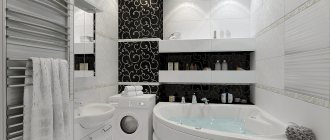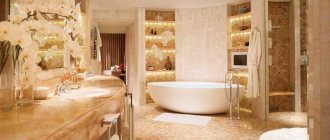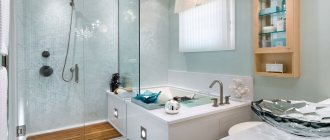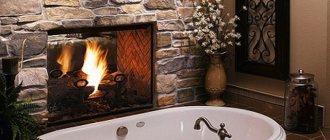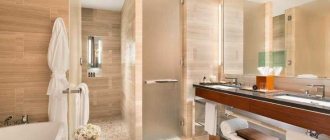Advantages and disadvantages
Let's look at the features of corner baths:
| Advantages | Flaws |
| The aesthetics of the corner bowl allows you to create an original interior design. | Models with a large radius in a narrow bathroom are placed close to the walls, which is not always convenient. |
| A variety of shapes helps you choose a suitable bathroom for a small bathroom, thereby saving its space. | Some deep products significantly increase water consumption. |
| The variety of materials from which bowls are made allows you to choose a product to suit any budget. | If the corner bowl is equipped with additional equipment, it is much more difficult to care for than a regular bathtub. |
Acrylic - a modern material
Acrylic bathtubs are a leader in sales because their cost, design, thermal conductivity and sound insulation parameters, and resistance to mechanical damage are optimal.
This is a relatively recently invented material, but its features have already been well studied. It has many advantages and practically no disadvantages, so even in a hundred years they will be making baths out of it.
Material
To choose a corner bathtub, you should learn more about the material from which it is made:
- Acrylic. The acrylic bowl is lightweight and quite durable. It retains heat perfectly and therefore saves hot water. Its main drawback is its complicated installation, since the bowl is attached in several places and placed on a brick “cushion”. To avoid purchasing a fake, you should pay attention to the cut of the side: if two layers are visible, then the corner bathtub is made of porous plastic and covered with a thin layer of acrylic.
- Cast iron. Wear-resistant bathtubs made of cast iron also retain heat well, but do not have a variety of shapes due to the peculiarities of production. They also have considerable weight and a high price.
- Steel. Resistant to scratches and impacts, lightweight. But corner steel bowls cool quickly and create additional noise when filled with water.
- Bathtub made of artificial stone. Eco-friendly material is resistant to various microorganisms, durable and easy to care for. Keeps warm well. The main advantage is the ability to make a corner bath of any shape and size.
- Cast marble. The bowl is made of marble chips and polyester resins. In appearance it can completely imitate natural marble, but at the same time has increased strength. Such a heavy bathtub can be installed without additional fasteners. Excellent heat retention.
The photo shows the interior of a spacious bathroom with a corner acrylic bowl covered with a decorative screen.
Thus, based on the desired design and budget, you can choose a bath that will suit you in all respects.
The photo shows the interior of a combined bathroom with a window and a double corner bathtub finished with mosaics.
Corner bathroom design with photo
Now designers very often resort to using corner bathtub models in their creations. They are also popular among those who care about the extraordinary design and luxurious appearance of the room. By installing such a bathtub, you will create a designer masterpiece from an ordinary bathroom. As a rule, such a model is installed in the corner of the room; in addition to the fact that it frees up space, as we said earlier, this arrangement of plumbing immediately creates a bright accent. Well, installation into a multi-level floor in the center of the room happens extremely rarely, because it is quite difficult to beat such a location of a bathtub of a specific shape, moreover, in this case it will take up a lot of space, and few people can afford it.
If we talk about the possible shapes of the bathroom itself, then sometimes there are corner spaces, in which case we can say that a corner bath is the only option to create a convenient, cozy and easy-to-use bathroom. Regardless of whether it is a combined or separate bathroom, it is almost impossible to place an oval or rectangular bathtub in a room of this shape - either nothing else will fit there, or you will not be able to feel comfortable there and you will end up with a very cramped room. This is why we recommend installing such a model - you will take up an extra corner, creating some kind of curvature of space, and the remaining space can be freely used. for example, to install a washing machine on one side and a toilet on the other side. Agree that such a division into zones will be quite convenient.
Photo from the site uutvdome.ru
Photo from interiormag.ru
Photo from roomplan.ru
Photo from the site tk-decor.ru
What types of bathtubs are there?
The range of modern corner bathtubs varies widely in shape and depth. Bowls can be symmetrical (regular geometric shape), which take up more space and are suitable for spacious rooms, and asymmetrical (products of unusual shape, where the wide part is designed on the right or left side).
The most popular model is the semicircular one - the classic shape looks attractive and expensive, but requires more free space. The triangular bowl takes up less space and fits perfectly into modest-sized bathrooms. A trapezoidal product is usually equipped with additional elements (for example, hydromassage) and is more reminiscent of a jacuzzi, since two people can bathe in it.
The photo shows a polygonal right-hand bathtub in the interior of a room in a minimalist style.
Fantasy without limits
Round bathtubs were created back in antiquity. This is a very convenient form. It guarantees a good mood, the effect of water procedures is the same as after visiting a beauty salon, which has a cosmetologist’s office, a massage therapist, and water procedures in the list of services.
In a three-room Khrushchev house, for example, you can try installing such a bathtub, because if desired, the hall can easily turn into a hall, and the bathroom into a spacious room, like the kitchen. Before buying a round bathtub, of course, you need to consult with specialists about remodeling and load-bearing walls.
A solution will be found, the problem will be solved in any case, even if load-bearing walls become an obstacle to the goal. It is possible to move the bathroom and place it away from public pipes.
In a one-room apartment, you will probably have to install additional partitions. Having drawn up a plan and approved it, you can begin work and enjoy the comfort of a round, spacious, pool-like bathtub for many years to come.
Photos of round bathtubs convince us that there is actually something to try for. They are beautiful, incredibly comfortable and suitable for most types of homes.
The main thing is to set a goal for yourself, change the stereotype, look at the square meters of living space like a master, through the eyes of a magician and wizard.
Design ideas
Corner baths can have different designs, fillings and designs. A small bathroom with a shower is very functional. The most practical way to protect furniture and finishes from water is to fence off the bathtub with glass doors or use curtains. Sometimes in the same room you can see both a bathtub and a free-standing shower stall.
The photo shows the interior of a bathroom in a classic style with a corner bowl combined with a shower stall.
The backlit model looks original and aesthetically pleasing, adding romantic notes to the setting. A bowl with many shelves serves as a functional piece of furniture, while a luxurious corner bathtub with glass looks modern and adds lightness to the interior.
The photo shows the interior of a bathroom, where everything is aimed at comfort and relaxation.
Particular attention should be paid to the corner bathtub on the podium: in a classic style, such a design looks majestic and monumental. Since a diamond-shaped or semicircular podium requires a lot of free space, the room must be spacious.
The photo shows a multi-level podium with a corner bath and shower.
Installation rules
The beginning of installation is the same as when using strip plinth: the tiles on the wall are washed, degreased, and dried. The same work is carried out with the edge of the bathtub, on which the plastic border will be mounted. If the gap is wide, it should be filled with cement or sealant and wait until the filler dries completely. Further actions will be as follows.
- The edge of the tile and the edge of the plumbing fixtures are taped with masking tape. This is necessary to ensure that the finishing material and the bath itself are not contaminated with glue or sealant.
- A plastic corner is applied to the joint; The required length is marked, after which the required fragment is cut off.
You can make a corner with a precise cut
- A layer of glue is applied to the junction of the bathtub and the wall. What composition to use is a matter for the master. You can also buy special adhesives, but practice shows that inexpensive and reliable “liquid nails” do the job perfectly. Please note: if the purchased border has been stored for a relatively long time, it may be necessary to clean and degrease the inside of the border before applying the composition.
The glue is applied evenly to the joint
- The corner is pressed evenly and tightly against the surfaces and held for some time to set. The required time period is specified in the instructions for the glue.
The corner is pressed to the desired area
- Excess composition squeezed out from under the fixed element is immediately removed. In about a third of an hour, it can be easily removed with a knife or a special tool.
Excess sealant is removed immediately
- Upon completion of installation, the tightness of the circuit is checked. Even small cracks should be filled with transparent sealant. Lastly, the construction tape is dismantled and the remaining working mixtures are removed (if you did not notice them in time).
The plastic border can also be joined using precise trimming. But corners decorated with fittings look more aesthetically pleasing, and it is better to cover the ends of the border with caps.
The junction of corners with the help of fittings looks more elegant
Photo in a small room
A corner bathing bowl can also be placed in the interior of a compact, narrow bathroom. As you know, the fewer corners, the larger the room appears. It is worth choosing a product exactly according to the size of the bathroom so that the space remains ergonomic.
The photo shows a small bathroom in beige tones with a semicircular bowl and a shower protected by matte doors.
Designers recommend choosing suitable plumbing fixtures and furniture for a corner bath - rounded sinks and bedside tables, a wall-hung toilet with a hidden cistern. This will make the bathroom look more spacious. Also, do not store hygiene products in plain sight and neglect mirrors in the interior.
The photo shows a bathroom in light colors with green accents and a wave-shaped sink.
The freed up space can be put to good use: install a washing machine, hang a shelf for decoration, or place a laundry basket.
What should you pay attention to when choosing a bath?
When you choose a bathtub, be sure to be aware of the dimensions of your bathroom; we recommend that even when you go shopping for the first time in order to ask the price and take a closer look, you have the exact dimensions of the room written down. Why is this necessary? It's simple. Firstly, prices also depend on the sizes, and secondly, this is necessary in case you really like some option, and when you come having already prepared and practically decided to buy, it turns out that the sizes do not match - just protect yourself from disappointment.
So, it is necessary to take into account the size in any case, because few people can boast of a large bathroom; more often we have to select options based on what we have. Classic bathtubs, both oval and rectangular, take up quite a lot of space, which would be useful for equipment or some other personal needs, but a bathtub that can be conveniently placed in a corner will free up almost half of the entire bathroom . This means that even the smallest apartment can accommodate a stylish bathroom with plenty of free space.
Important
Be sure to know the dimensions of your bathroom; this is necessary so as not to make a mistake when choosing plumbing fixtures.
If we talk about the specific dimensions of a corner bathtub, then usually all standard models do not exceed 160 centimeters in length, of course, there are some differences, both positive and negative, and this directly depends on your personal preferences, wishes and, accordingly, on necessary. One of the big advantages of this shape is that despite the fact that, it would seem, the angle should interfere and create discomfort, such bathtubs are very comfortable and allow you to comfortably fit even two people. Due to the angular shape, the size increases, and a bathtub of this model turns out to be larger than any other oval or rectangular one. In terms of displacement, by the way, they also exceed those of the classics, and in order to fill the bath faster, special cascade mixers are installed, which are built into the structure itself.
Examples for a combined bathroom
A bathroom with a corner bath and toilet is another good way to make the room feel more spacious. At the same time, the arrangement of furniture and plumbing is simplified: due to the absence of a partition, space is freed up for a bathtub, toilet and sink, which is especially important in panel Khrushchev-era buildings.
The photo shows a rounded corner bathtub in a combined bathroom, decorated in black and white.
A combined bathroom with a corner bath is appropriate not only in apartments, but also in private houses, which is due to the peculiarities of the location of communications. In addition to the basic plumbing, you can find a place in the room for a bidet, and zone the toilet with a partition.
Bath glass
The design of a bathroom with a round glass bathtub can be anything you want, thanks to the use of various additional decorative elements. A round glass bathtub is an extraordinary and strange thing.
No one had used glass to make sanitary ware before. They learned how to create a super-durable version that meets market needs in the 20th century. It is difficult to break, scratch, and easy to wash.
To make a decision, to decide whether you really like a glass round bathtub, you need to reveal the secret of the charm of this material, think a little about its meaning and essence.
Bath in various interior styles
The style in which a corner bathtub looks most harmonious is classic. It can act as a luxurious bath or, conversely, unobtrusively fit into the interior. The bowl in the traditional style is decorated with marble or mosaic tiles, fit into the podium and even decorated with columns.
Scandinavian style is ideal for both apartments and country houses, since the base color used in such an interior is universal white. A corner bathtub fits perfectly into a bright space, saving space and adding attractiveness to the environment.
The Mediterranean style is also suitable for a country house, which, with the help of bright colors and natural materials, conveys the atmosphere of a southern resort and puts you in an optimistic mood. A corner bathroom in such an interior will help you relax and unwind.
The photo shows a bathtub in a classic interior, trimmed with rectangular marble tiles.
Art Nouveau style combines minimalism and decorativeness at the same time, and also welcomes smooth lines in furniture and calm tones. A corner bathroom will highlight the features of the interior in the Art Nouveau style and dilute the strict atmosphere.
A modern-style bathroom is not only aesthetically pleasing, but also functional. What could be more practical than a corner bath? In addition, the variety of shapes and colors of products gives scope for fresh and extraordinary design ideas.
How to install on a bathtub
Before installation, the gap between the wall and the bathtub must be filled with sealant
- Thoroughly clean the joint of any dirt and apply a layer of degreaser.
- Taking into account the width of the structure, seal the sides of the container and a section of the wall with masking tape (3-4 cm above the level of the corner).
- After the coating has dried, seal the joint between the walls and the bathroom with sealant or cement mortar.
- Cut the corner according to the required dimensions (for greater accuracy, attach it to the mounting location).
- Liquid nails are ideal for fixation. After applying the composition, the section is pressed and held in this position for 60 seconds.
- Then the remaining cracks and joints are sealed with transparent sealant.
To improve the aesthetics of the structure, plugs are used.
So, corners for sealing the bathroom will easily and quickly eliminate leaks. Before purchasing, it is necessary to take into account the planned or existing design and financial capabilities. It is not necessary to spend fabulous sums. The variety of materials offered allows you to choose both expensive and budget options.
How to choose the right one
This question is asked by everyone who decides to finish the bathroom with tiles themselves. It must be said right away that the variety of trims depends on the thickness of the tiles. Therefore, these decorative elements are numbered from 6 to 12. Essentially, this is the distance from the base of the element to the edge of its perpendicular strip in millimeters.
Attention! Professionals recommend purchasing a corner one size larger than the thickness of the tile. For example, if the thickness of the tile is 6 mm, then the corner number should be “7”.
- If the trim is matched to the color of the ceramic tiles, then you need to compare their shades in the store. Although designers have different approaches to the selection of colors for bathroom cladding elements. Some people believe that diverse shades only improve the visible view, emphasizing the location of walls and floors, and plumbing fixtures.
- If the walls in the bathroom have a non-standard shape, which means their joints may be curved, then it is clear that it is better to choose plastic corners for finishing them. They are flexible, so there will be no problems with installation exactly along the joint.
- In so-called wet areas, it is better to install tile corners with rubber seals. They fit tightly to the ceramic without creating gaps. Wet areas include areas around plumbing fixtures such as sinks, bathtubs, and showers. Their size is half a meter from the devices.
As for the amount required to seal the corners of the bathroom, it is simply measured by the corners (external and internal separately), 5-10% is added to the resulting values. For example, the standard ceiling height in the bathroom is 2.7-2.8 m, which means that the length of one trim is not enough to cover the corner of the room. Therefore we will have to add.
How to make a corner bath more comfortable?
When purchasing plumbing equipment, you can also buy additional accessories that will make it more convenient. For example, the height can be adjusted based on your needs - all you need to do is buy legs. Rarely does anyone think about how many times a person falls in the bathroom in his life - after all, this is the most frequently visited slippery place, to avoid unpleasant falls, buy railings, you can also buy step-ladders, but be sure to cover them with rubber or a special mat. You can complement your purchase with a headrest that attaches to suction cups and armrests, then every bath time you take will be luxurious.
If your bathtub is equipped with a shower, as is the case in most cases, be sure to purchase a curtain; it will protect against large amounts of water getting over the side. Since the bathtub is non-standard in shape, in the same store purchase a special handrail for attaching a curtain of the same shape.
Types of bathroom corners
There are several types of corners, differing in material of manufacture, appearance, color and even installation method. Some manufacturers even offer products that are self-adhesive, so to use them you simply remove a special protective film, after which they are glued to the desired area in the room. Other items are fixed with special mechanical fasteners.
Tape (self-adhesive)
Gluing a ribbon corner is incredibly easy, so this job is accessible to everyone. The process is carried out in several variants, and usually the product itself is equipped with a special self-adhesive base during the production process, so there is no need to purchase additional glue for the job. To increase the reliability and durability of gluing the element, it is still recommended to purchase a high-quality sealant.
The entire installation process is divided into stages:
- Initially, the optimal size and thickness of the product is determined, for which the dimensions of the existing joint between the bathroom and the walls of the room are measured;
- a high-quality ribbon corner is purchased, and it is desirable that it is not the cheapest, since otherwise there is a high probability that it will not last too long;
- The protective film is removed, after which the element is glued to the desired areas of the room.
A properly glued corner with the additional use of high-quality silicone sealant will last a long time and will also serve its purpose perfectly.
Ceramic
Ceramic products are highly popular because they are reliable and durable. They are truly beautiful and unusual, and are also available in numerous colors, which makes it possible to choose the best option for each tile covering.
Their main advantages include:
- attractive appearance;
- hardness, thanks to which structures retain their shape for a long time;
- ceramics is an environmentally friendly material that is easily used in residential premises, so it does not harm people in any way;
- water does not affect the product in any way;
- many manufacturers produce ceramic corners in numerous types, differing in design, size and appearance;
- exposure to various factors does not lead to loss of brightness and attractiveness of products.
The disadvantages include the lack of high resistance to various mechanical impacts, so different impacts usually lead to serious damage to the corners. Due to low plasticity, it is quite difficult to install structures. The entire installation process is divided into stages:
- the optimal design for the bath is selected, having the required dimensions and thickness;
- the surface must be cleaned of various contaminants and dust, after which a degreasing solution is applied;
- the joint is completely filled with a high-quality sealant that has high moisture-resistant parameters, and it can also be replaced with cement mortar, but in the latter case, you must work carefully so as not to stain the coating and plumbing fixtures;
- Next, a ceramic corner is glued using a special glue, and it is important to immediately remove excess glue;
- the structure is certainly leveled and also pressed against the wall with force;
- If after work there are small gaps, they are removed with sealant.
A properly glued ceramic corner will look bright and attractive, and will also last a long time even in aggressive conditions.
Dimensions of ceramic corners
Application of silicone sealant
Plastic
These designs are considered the most popular and frequently purchased. They are represented by profile strips, and their length is usually 2.5 m. They are formed using polyvinyl chloride, which is an ideal solution for carrying out various work in rooms with high humidity. Its advantages include:
- gluing a plastic corner is quite simple, so even a beginner can easily cope with this process;
- easily withstands sudden temperature changes;
- not afraid of moisture;
- prevents the formation and development of fungi or mold;
- has a low and affordable price;
- Available in numerous colors, so you can choose not only a standard white product, but also corners made in a variety of colors;
- good flexibility greatly facilitates installation, and also makes it possible to use the corner even for baths of unusual shape.
Plastic corners for the bathroom are installed in the correct sequence of actions:
- the tiled surface is initially prepared for work, so the joint is thoroughly cleaned of various contaminants, after which it is coated with a high-quality degreasing compound;
- it is important to wait until the coating is completely dry, otherwise the material will not stick well and properly;
- the joint between the plumbing and the walls of the room is sealed with sealant or cement mortar;
- masking tape is glued to the edges of the bathtub and tile covering, protecting the materials from glue and sealant;
- a corner is applied to determine how to cut it correctly;
- how to glue a plastic element: liquid nails are most often used for this, ensuring reliable and durable fixation of the object;
- the corner is pressed tightly against the desired area of the room, after which you need to hold it in this position for a while;
- After gluing it, small cracks and joints are sealed with transparent sealant.
To increase the attractiveness of the resulting design, it is allowed to use various plugs or other fittings.
Stages of installing a plastic corner
Installation Rules
Made from natural stone
Such corners are distinguished by their beautiful appearance, high cost and durability. They are not flexible, so they are usually used exclusively for bathtubs of standard shapes and sizes. There are many types of natural stone, so a product with optimal appearance and parameters is selected.
The product is usually used in bathrooms with a unique design. It goes well with luxurious and expensive sanitary fixtures and coatings.
How to install such a structure? For this purpose, high-quality adhesive compositions specially designed for natural stones are also used.
Silicone
These products are flexible and quite attractive. They are most often used in places characterized by the presence of numerous bends or other distortions. Therefore, they are ideal for baths of non-standard, unusual shapes.
The downside of the products is their instability to various modern chemicals, so it is not advisable to clean them with these solutions.
When purchasing a silicone corner, it is important to consider its shelf life, since the adhesive used by manufacturers to glue the element loses its properties 2 years after application.
Installing such a structure is quite simple, since you just need to cut the element correctly and also remove the protective film. Next, it is glued to the desired area in the room.



